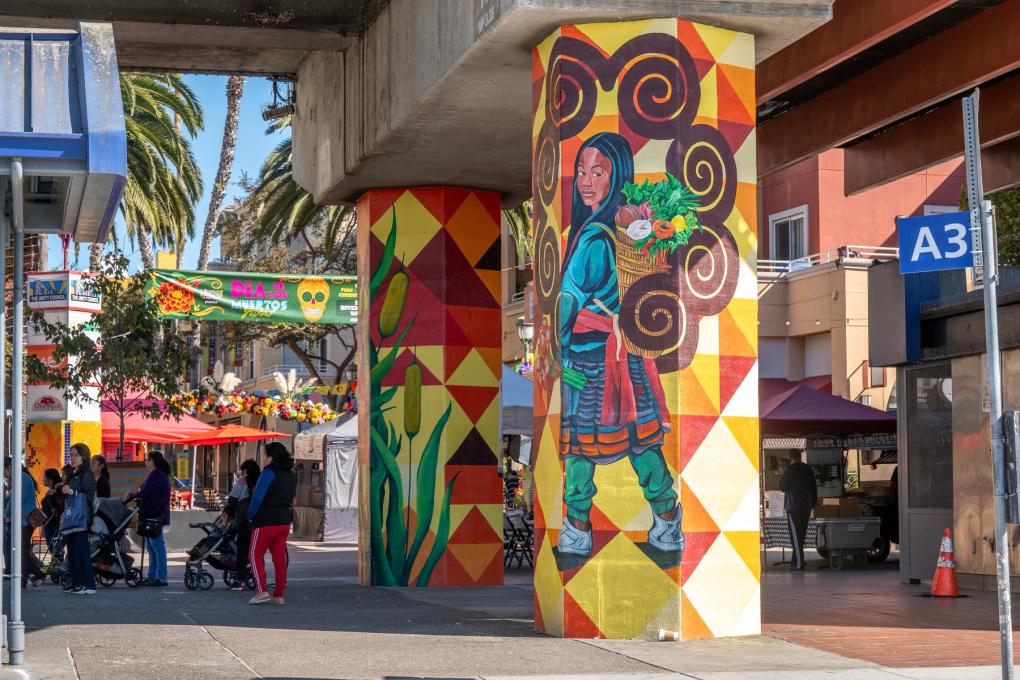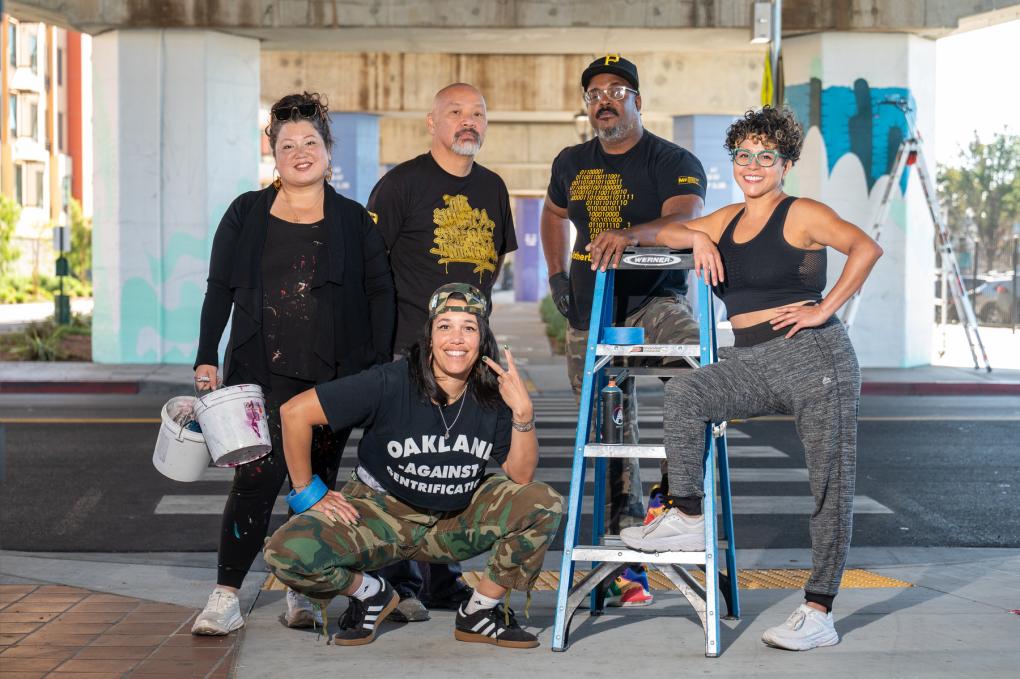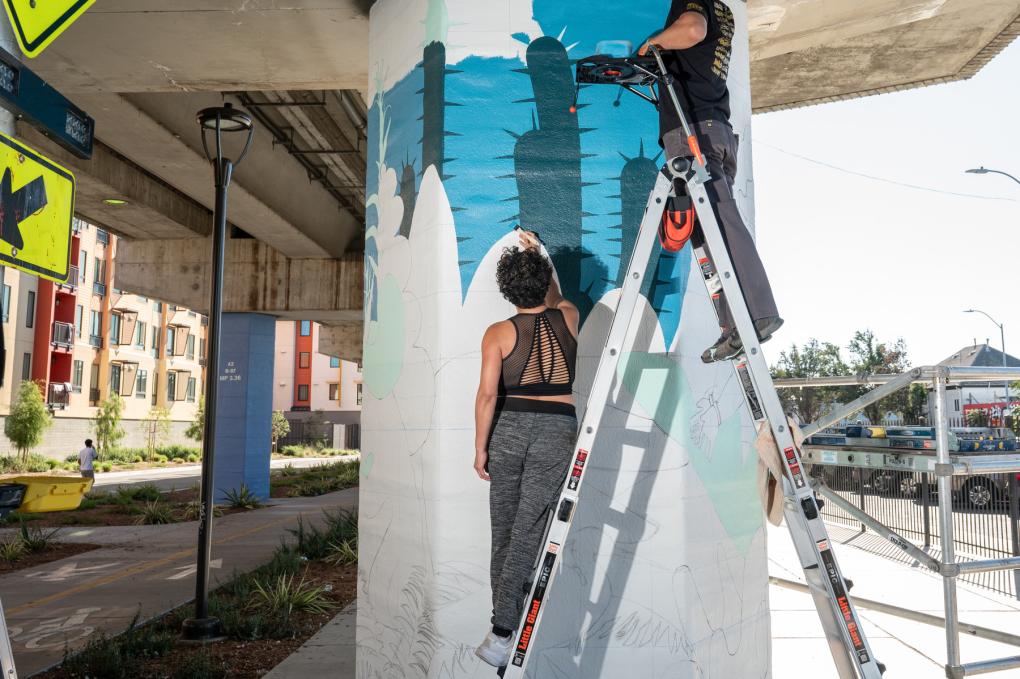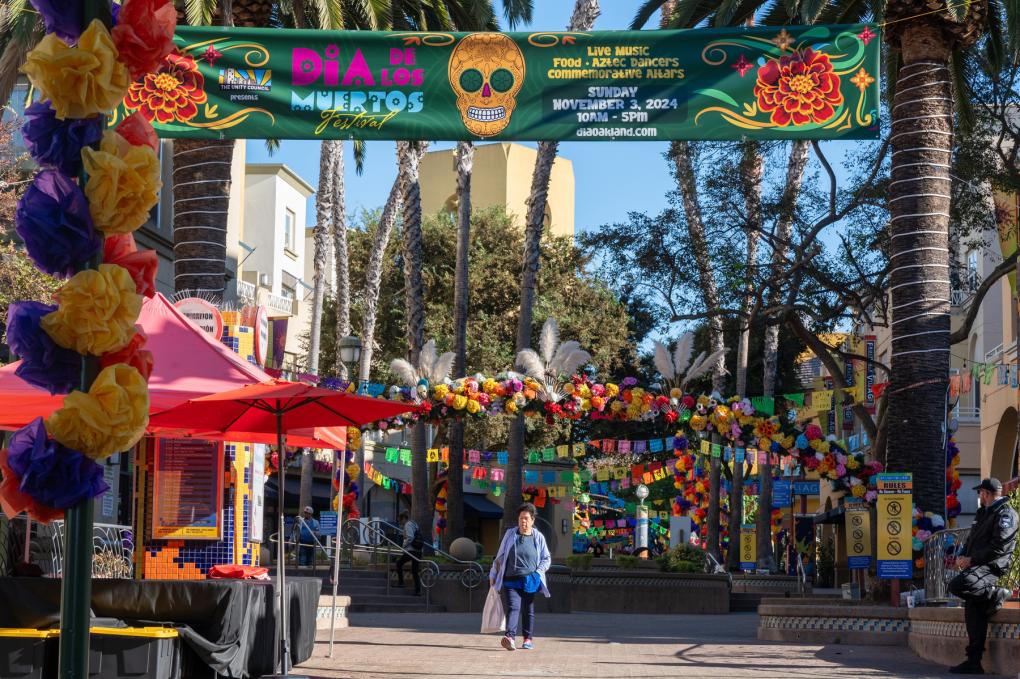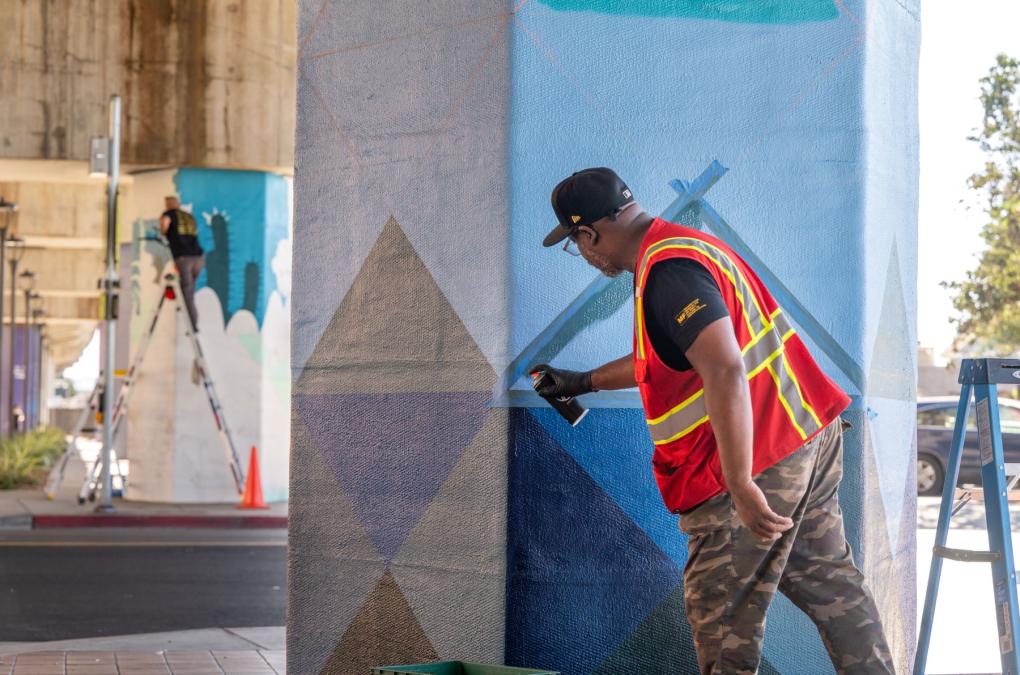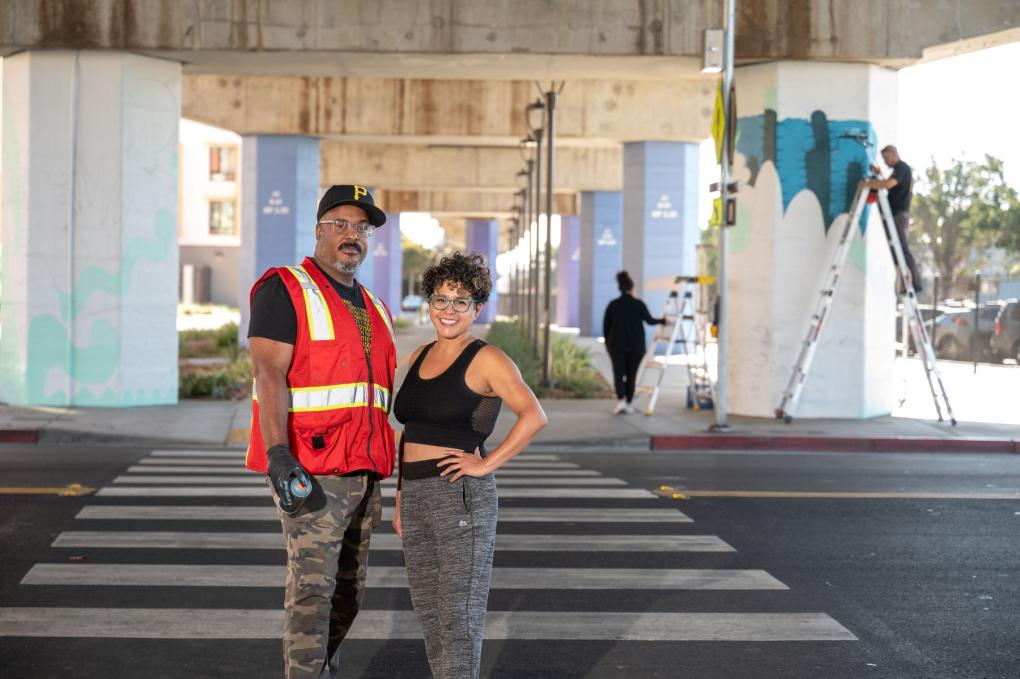Search Results
BART's annual Holiday Toy Drive collects more than 1,500 toys and $1,700 in gift card donations
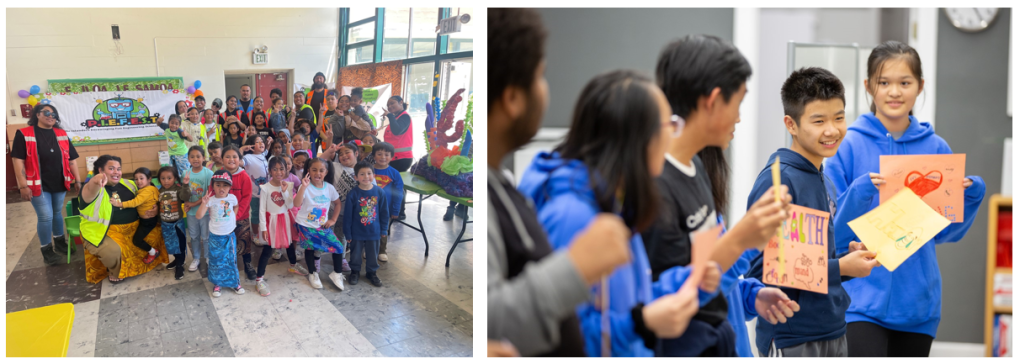
Left Image: A STEAM event with one of SCDC’s collaborative partners, "P.I.E.F.E.S.T." (Pacific Islanders Encouraging Fun, Engineering, Science & Technology). Right image: Participants from CYC’s Bayview Youth Advocates program work on an exercise of gratitude.
Update: The BART Holiday Toy Drive collected more than 1,500 toys and $1,700 in gift card donations this year. The toys were presented to the two recipient organizations, the Samoan Community Development Center of San Francisco (SCDC) and the Community Youth Center of San Francisco (CYC), during the December 21 meeting of the BART Board of Directors.
Each winter, BART gives back to the communities it serves with its annual Holiday Toy Drive, soliciting donations in the form of new, unwrapped toys and gift cards from employees. The donations are gifted to local organizations, selected by the BART Board President from within their district, in a joyful ceremony during the final BART Board meeting of each year.
Board President Janice Li selected two recipient organizations this year: the Samoan Community Development Center of San Francisco (SCDC) and the Community Youth Center of San Francisco (CYC).
“For immigrants like me, holiday time is community time. Growing up, it was important to me to have community spaces where I could speak my language, celebrate my culture, and be proud of my heritage,” Li said. “Organizations like CYC and SCDC are so critical to building welcoming and healthy communities"
She continued: “Both of these organizations have humble beginnings and have always been rooted in supporting youth and families in the community. I love that they believe in and know how to do transformational work, particularly for AAPI communities in the southeastern neighborhoods of San Francisco, where there are fewer resources and services available.”
BART’s Office of External Affairs and BART Police sponsor the drive each year. In 2022, BART collected more than 750 toys and $500 in gift cards for Building Opportunities for Self-Sufficiency.
“The Holiday Toy Drive is the highlight of the season for many BART employees. We are gratified to spread joy and cheer to local children and their families, many of whom rely on our system to get to school, to work, to appointments, and to gatherings with their families during the holidays,” said Rodd Lee, Assistant General Manager of External Affairs at BART. “It is a special honor to work with historic organizations like SCDC and CYC, who have long been committed to making the Bay Area a better place for our youth.”
SCDC and CYC support San Francisco youth with an incredible array of services, including afterschool programs, summer camps, mentorship programs, mental and physical health services, and enrichment activities. CYC was founded in San Francisco Chinatown in 1970 and serves youth across the city, aiming to provide them a sense of belonging as well as essential tools to succeed at school and in life. SCDC is located in the Visitacion Valley neighborhood of San Francisco, where it has worked for more than three decades to improve the quality of life for Samoans and Pacific Islanders in the Bay Area. It is the only funded organization in San Francisco that is devoted to supporting these populations.
Every single one of Treanna Noa’s seven children, ranging in ages from five to 21, has participated in SCDC’s programs.
“SCDC has opened so many doors for us. I don’t know where we would be without the center,” Noa said.
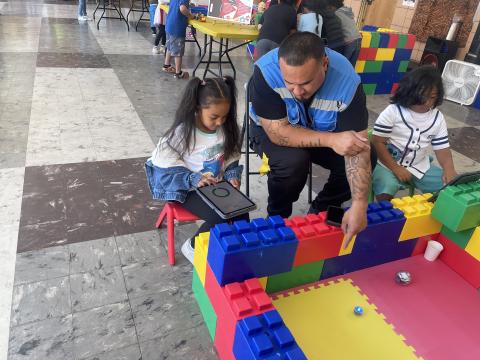
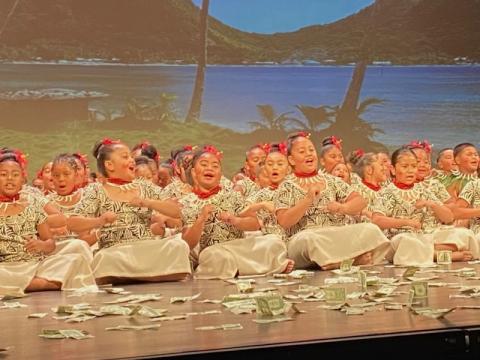
Top image: A STEAM event with one of SCDC’s collaborative partners, "P.I.E.F.E.S.T." (Pacific Islanders Encouraging Fun, Engineering, Science & Technology). Bottom image: A snapshot of SCDC’s PIYA Summer Celebration 2023.
SCDC “picks up where my kids’ schools are lacking,” she said. The children’s schools don’t have STEAM programs, for example, but every Wednesday, SCDC brings in a STEAM facilitator to teach kids about science and technology after school. The facilitator is a member of the Pacific Islander community, Noa said, and therefore understands the unique challenges her children experience in school and at home.
“My kids aren’t as open as they could be with their schoolteachers. They think, oh, you wouldn’t understand what I’m talking about; I’m Samoan, and we do things a bit differently,” she said. “Having someone who looks like you and who can relate to you, it brings your guard down and you’re more open to receiving information.”
Noa said SCDC even picks her younger children up from school, and the center provides them with a safe, supportive space where they can finish their homework until Noa gets off work. She said if SCDC didn’t exist, she wouldn’t be able to afford childcare.
“They do so much for us, including things we didn’t even ask for,” she said, like hosting drive-through graduations for her children when they finished high school and kindergarten during the pandemic.
“They have made life so much easier for us,” she said.
Susan Tan’s son, Ben, began attending CYC's afterschool program when he was in middle school. She credits the organization with helping him become the person he is today.
Ben was a preteen when he and his mother immigrated to San Francisco from China. They didn’t know English very well and assimilating was difficult. Ben struggled in school, behaviorally and academically, and his mother recognized his struggles as “a cry for help.”

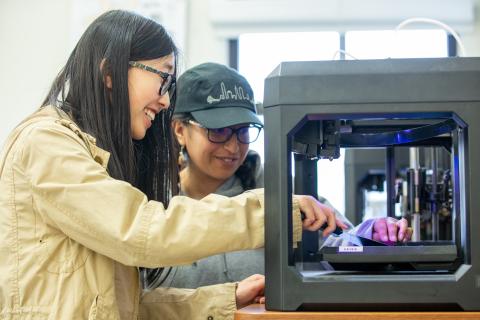
Top image: Erica Mitchell works with a student from Redding Elementary on academics at CYC’s afterschool program. Bottom image: Stefanie Almendares works with a student from Aptos Middle School during a 3D printing workshop as part of CYC’s STEM program.
“I reached out to everyone I knew to see if anyone could help, and CYC was one of the names that came up,” Tan said, speaking through a translator. She took a parenting class first, where she learned to be more patient and communicative, and then enrolled Ben in CYC's afterschool program. In the span of just two or three years, she said she saw him blossom and transform.
“It became a second home for him. I was working so much, and there was nowhere for him to go after school,” she said. At CYC, she knew Ben was safe.
Today, Ben is studying math and computer science at the University of California at Santa Cruz. Last summer while home from school, he participated in CYC’s transitional-age-youth program.
Administrators at CYC and SCDC said they are honored to be this year’s BART Holiday Toy Drive recipients. They emphasized the toys will immensely brighten their youth participants’ holidays. The organizations will receive the toy donations during the December 21 BART Board meeting at BART Headquarters.
“The majority of our youth come from low-income families, and they don’t necessarily have the means to give their kids many presents, if any presents. To provide families with something as simple as a toy can have a profound impact,” said Ben Mok, CYC Community Relations Manager.
Michelle Wu, a communications consultant for CYC, added: “One of the things we believe in the most is providing access to things, including providing access to moments of joy.” The toys from the drive will specifically go to youth at CYC’s Bayview program.
Lynn Peleseuma, Senior Program Specialist at SCDC, said her organization hosts a holiday celebration every winter before the kids start winter break. There’s caroling, cultural dancing, and festive food and drink. At the gathering, Peleseuma and her colleagues “want to make sure each and every kid has a toy to unwrap.”
“To get toys from BART, from folks in our community, is a blessing for us,” she said. “And it’s a blessing to our kids and their parents.”
If you are a member of the public interested in gifting a donation to SCDC or CYC, you can visit their websites here and here.
Debora Allen
Montgomery St.
BART's low-income fare discount to increase to 50% on Jan. 1: Here's how the program impacts an East Oakland community
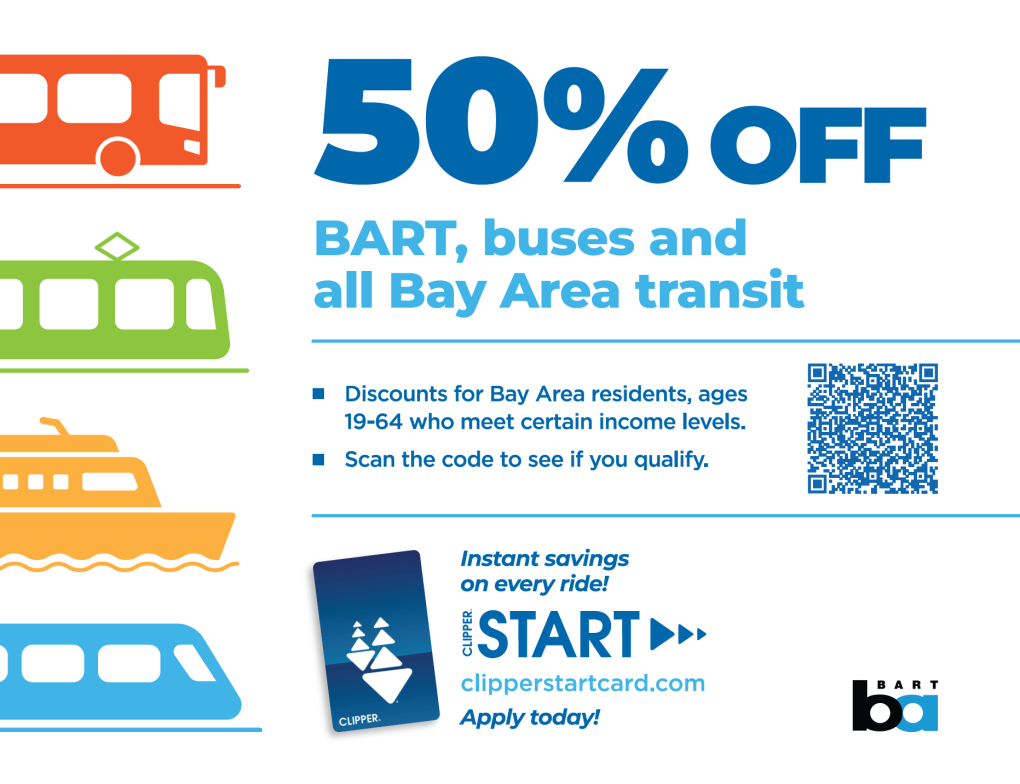
BART is helping lower-income riders pay their fare by increasing its Clipper START means-based fare discount from 20% to 50%, beginning Monday, Jan. 1, 2024. This means that Clipper START users will pay half the regular BART fare.
Clipper START, a pilot program facilitated by the Metropolitan Transportation Commission, offers the discount for Bay Area residents ages 19 to 64 whose incomes are less than 200% of the federal poverty level. Clipper START is accepted by more than 20 regional transit operators. Those who qualify can apply for the program here.
Keep scrolling to read about an East Oakland-based organization's efforts to register people for Clipper START and hear about its impact on community members.
BART offers multiple fare discounts in addition to Clipper START, including discounts for youth (50% off with a Youth Clipper card), seniors (62.5% off with a Senior Clipper card), passengers under 65 with qualifying disabilities (62.5% off with an RTC Clipper card), and a High-Value Discount (adult Clipper users who buy $45 or $60 Clipper cards when autoload is set up get $48 and $64 worth of value, or a 6.25% discount).
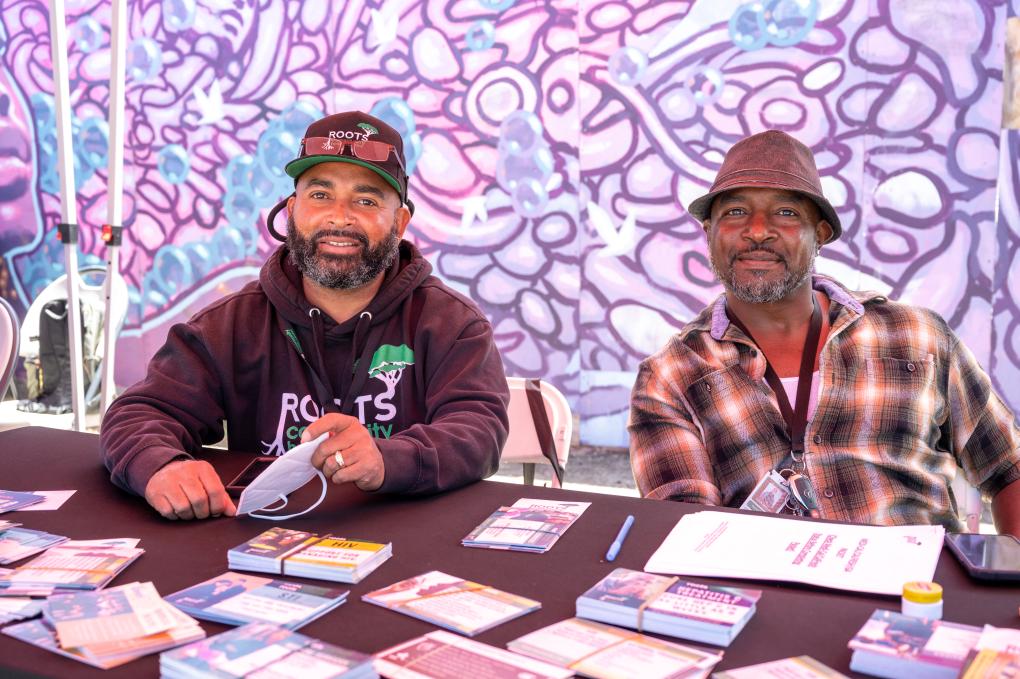
Members of the Roots Community Health Center outreach team. Roots conducts outreach to promote and register community members for Clipper START.
“When you have a Clipper card, your first thought isn’t 'I can't' but ‘What time can I get there?’” says Jamaica Sowell, who has witnessed firsthand the importance of increasing access to affordable transportation in the Bay Area.
Sowell is the Director of Programs and Policy at Roots Community Health Center, an organization working to uplift people impacted by systemic inequities and poverty, especially in a stretch of the East Oakland community known as the 40x40, where nearly half of Black families living in poverty in Oakland reside.
Since 2022, Roots has been conducting outreach to promote and register community members for Clipper START, a pilot program from the Metropolitan Transportation Commission (MTC) that offers discounts on transit fares. To qualify, applicants must be Bay Area residents between the ages 19 and 64 with a gross annual income at or below 200% of the federal poverty level. Beginning January 1, 2024, BART’s Clipper START discount increased from 20% to 50%, meaning users pay half the regular BART fare.
Roots Clinic has a holistic approach for supporting the health and well-being of the communities it serves. Enabling access to transportation, especially affordable transportation, is a key piece of the puzzle.
“Mobility has a lot to do with access, including things like health care,” said Sowell. If people don’t have the means to get to the Roots’ clinics, “they’re not going to come.”
Mobility is a central component of one's physical and mental health, Sowell stressed. Transportation, especially affordable transportation, ensures that people can access things like medical appointments, mental health care, treatment programs, benefits enrollment support, and other crucial services that organizations like Roots offer.
But going to appointments is "just one facet” of the benefits of public transportation to community members, Sowell said. Transportation gives people easier access to civic engagement activities, like city council meetings, and takes people to parks and green spaces, where you can walk, soak up sunshine, picnic with your family, and play sports with friends. For some people, just getting out of their neighborhood for a few hours is healing in and of itself.
“Transit takes you places outside your own block, including places you might not have had access to before,” Sowell said.
Clipper START actively conducts outreach to organizations like Roots, which have well-established lines of communication and trust within the communities they serve. Sowell said Roots jumped at the chance to partner with MTC on Clipper START because her organization understands the specific needs of the East Oakland community.
“When our people hear Roots is partnering with MTC and BART, it automatically establishes buy-in,” she said. “Our community members trust us and trust that we’ve vetted the program.”
Since Clipper START launched in June 2020, MTC reports that more than 30,000 people have signed up for the program. Between 2020 and 2022, the period for which the most recent data is available from MTC, Clipper START users took more than 1 million transit trips, with most of these trips taken on BART (40% of total trips).
“[Clipper START] makes me want to do more [with my family] on public transportation for necessity, but also for fun, like going to San Francisco for free museum days,” one user said.
As awareness of the program grows around the region, so too does usage.
That’s in no small part thanks to organizations like Roots, whose outreach teams promote the program at community events, apartment complexes, encampments, faith-based organizations, and door to door. Roots is exploring additional outreach avenues for the new year.
“Being able to tap into a discounted transportation platform like this is huge for our folks,” Sowell said. “Clipper START has been beneficial in improving transportation accessibility to our East Oakland community, and we look forward to our continued partnership in the new year.”
Rebecca Saltzman
Take BART to The Unity Council’s Día de los Muertos Festival (Sunday, Nov. 3) and view 5 new murals at Fruitvale Station
Purchase a BARTy x Dia de los Muertos t-shirt and stickers on Railgoods.com.
Scroll down to read this news release in Spanish.
BART invites you to take public transportation to The Unity Council’s Día de los Muertos Festival on Sunday, Nov. 3, from 10am to 5pm, in Oakland’s Fruitvale neighborhood. This year, the annual event coincides with the unveiling of new murals on ten columns in the unpaid area under the platform of Fruitvale Station. The mural project was spearheaded by The Unity Council, and all of the artworks were created by Oakland-based artists: Senay “Refa One” Alkebulan, Cece Carpio, Jet Martinez, and Favianna Rodriguez. (Note: Some murals are works in progress.)
“Since its founding in 1964, The Unity Council has been dedicated to uplifting and advocating for underrepresented communities,” said Unity Council CEO Chris Iglesias. “Today, we build on that legacy with new affordable housing developments near a transit hub, featuring murals that reflect our community’s culture. At the Fruitvale BART station, our latest murals celebrate Fruitvale’s rich cultural heritage, transforming the station into a vibrant, welcoming environment and a testament to the community’s creativity, resilience, and unity.”
Said BART Director Robert Raburn, whose district includes Fruitvale: “The thumbprint of the community is on Fruitvale Station. Thanks to the partnership between BART's Art Program and the Unity Council, talented local artists created beautiful murals with designs that reflect the vibrant Fruitvale neighborhood.”
BART is a longtime partner of The Unity Council and supporter of the Día de los Muertos Festival, a free outdoor event that brings more than 100,000 people to the Fruitvale neighborhood with live music, games, rides, activities, arts and crafts, Latin American artisans, and incredible altar artistic installations created by community members to honor los muertos.
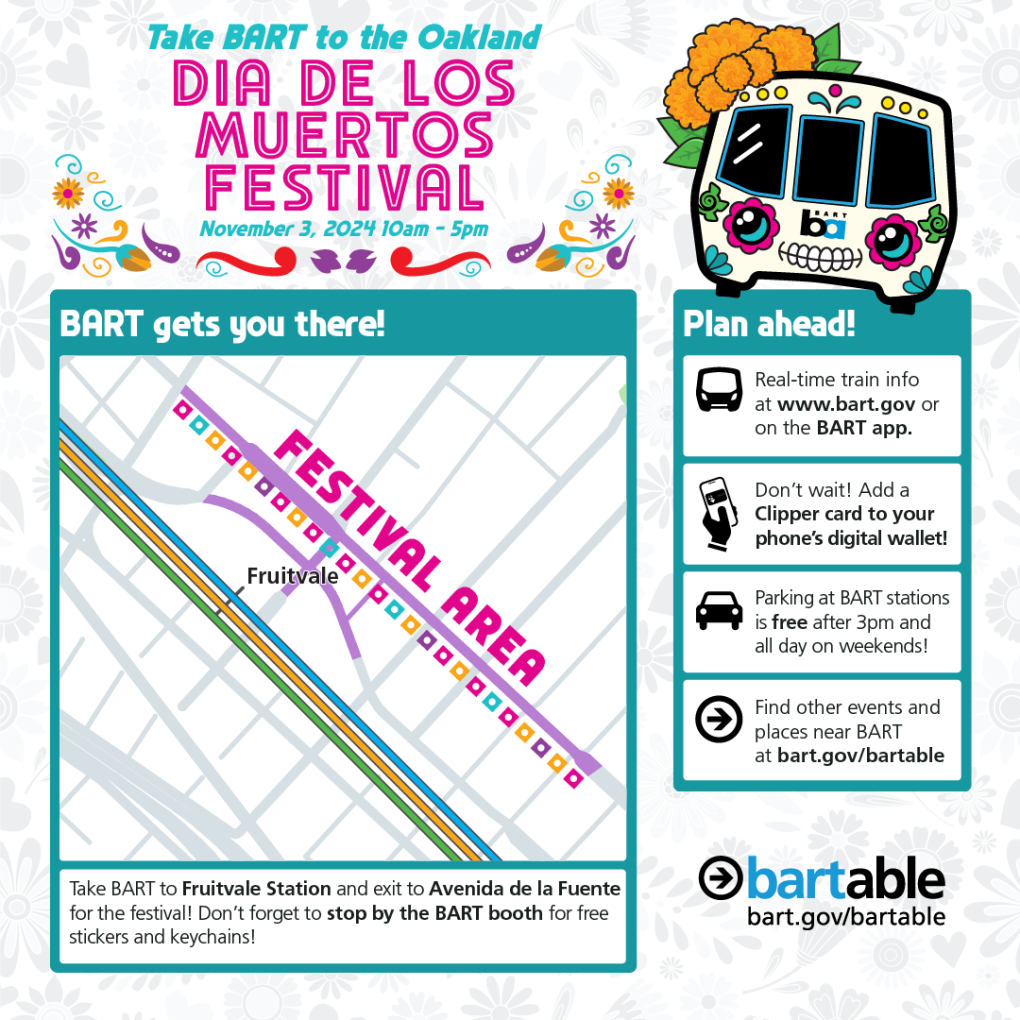
As you enjoy the festival, BART and The Unity Council encourage you to wander among the beautiful new murals, which have contributed to the transformation of the station into a living canvas that reflects the diversity and cultures of the local community. Fruitvale has become a destination for mural making, and the creation of this street gallery at the station is a reflection of the neighborhood’s many culturally rich public artworks. The unveiling of these murals is especially timely given that art, culture, and community gatherings are central components to the Día de los Muertos holiday.
"The murals we are creating at the Fruitvale BART station are not just standalone works of art; they are part of a larger, interconnected vision that extends across the community,” said Evelyn Orantes, Curator. “By linking them with the murals at CASA Sueños, just across the way, we are forming a cohesive 'street gallery'—a vibrant, open-air collection that celebrates the rich cultural heritage and creative energy of Fruitvale. This concept not only beautifies the area but also transforms our public spaces into a dynamic gallery where art and community intersect, inviting residents and visitors alike to experience the neighborhood as a living canvas.”
The idea for the street gallery gained momentum following the 2019 completion of the Fruitvale Station “Long Live Oscar Grant” mural by Refa One, an Oakland artist who also created artworks for this mural project. The five murals were developed and funded by The Unity Council with support from the BART Art Program and a significant grant from the Rainin Foundation. The Unity Council selected the four artists through a process that ensured the vibrant community around the station would be meaningfully honored and reflected.
BART is working to continue deepening its relationship with the historic Unity Council and the Fruitvale community by supporting efforts like this culturally resonant street gallery, which not only reflects the identities of many of the people who live in the neighborhood but contributes to making Fruitvale Station a brighter and more welcoming space to everyone who passes through.
Said Jennifer Easton, BART Art Program Manager: "Art has a critical role in defining spaces. The new murals flipped a switch on Fruitvale Station making its relation to Fruitvale Village and the rest of the Fruitvale neighborhood one of welcome and celebration. Through this monumental partnership with The Unity Council, the BART station now aligns with the cultural richness of the community.”
BART and The Unity Council’s longtime partnership
For decades, BART has partnered with The Unity Council to support the Día de los Muertos Festival and encourage the public to ride BART to the festivities.
BART Director Robert Raburn and BART staff will have a booth at the event to provide information about relevant BART programs, chat with the community, and hand out free keychains and Día de los Muertos x BARTy stickers. Show your spirit for the event and BART by purchasing a BART Día de los Muertos t-shirt on Railgoods.com.
“For over a decade, BART has proudly partnered with The Unity Council to support the annual Día de los Muertos celebration in Oakland's Fruitvale District,” said BART Principal Marketing Representative Jill Buschini, who oversees BART’s external partnership program. “It is an honor to collaborate on this event each year, not only because of The Unity Council’s tremendous contributions to the Fruitvale community, but also for the way this cherished tradition brings people together. The celebration honors loved ones and embodies the cultural richness that resonates with both residents and visitors alike. With the event's growing popularity, taking BART is a convenient and eco-friendly alternative to driving, making it easier for everyone to enjoy the murals and festivities.”
About The Unity Council
The Unity Council is a social equity development organization devoted to improving the quality of life, economic and educational opportunity, and health and safety of low-income communities. The Unity Council was established in 1964, during the civil rights movement, by a group of community members who wanted to ensure the political representation of the Latino community. The organization’s programs and geographically based community development strategy now focuses on building an economically vibrant, physically attractive, and livable neighborhood for the Fruitvale community regardless of ethnic affiliation or national origin. Today, TUC serves over 11,000 clients annually in five languages in the following program areas: early childhood education, youth mentorship and leadership development, employment services, career readiness training, housing and financial stability, senior citizen services, affordable housing and neighborhood development, and arts and cultural events.
About the neighborhood and the Fruitvale Transit Village
The Lisjan Ohlone people, who thrived in the region long before the arrival of European settlers in 1769, are the original inhabitants of the territory of Huchiun. Their rich and vibrant culture has deep roots in the land that would become more widely known as the vibrant city of Oakland.
In the 1800s, the area surrounding the Fruitvale BART Station held a different identity - 'Fruit Vale.' This name was bestowed upon the neighborhood due to its lush and abundant apricot and cherry orchards. The bountiful fruit trees that graced this area not only offered sustenance, but they also added a natural beauty and allure to the landscape, which has since evolved into a thriving urban center known for its diverse and rich history.
Today, it's a vibrant neighborhood and one of Oakland's main commercial areas. Fruitvale is hailed as one of the most diverse districts in Oakland. Its residents have said that the district’s diverse cultural community makes it an ideal place to live and raise children. The largest concentration of Oakland’s Latine population resides in Fruitvale, and the district hosts some of Oakland’s most popular cultural events and International Blvd is a major shopping and dining corridor. Fruitvale is also 25% persons of diverse Asian backgrounds, and 10% Black.
Fruitvale Village, created by The Unity Council in the early 2000s, is a national model for livable communities. Located in the heart of the vibrant Fruitvale neighborhood, Fruitvale Village is a mixed-use development with prime retail spaces, offices, a high school, senior center, and apartments. Fruitvale Village is adjacent to the Fruitvale BART station, the system’s 4th busiest and 9th most widely traveled station, and a bustling AC Transit hub, making the property an internationally renowned Transit-Oriented Development (TOD). The pedestrian plazas running through the Village are host to weekly farmers market and event spaces and are a great place to sit and enjoy the sun.
About the artists
Senay “Refa One” Alkebulan is an Oakland native who has been instrumental in the development of the innovative genre known as “Aerosol Art” (Spray Can/Style Writing). Refa's refined HipHop calligraphy is inspired by a cultural tradition originating from the New York City subway art movement. A lifetime of involvement in HipHop culture and political organizing has afforded Refa a successful career as a professional muralist, illustrator, activist, and arts educator. His work has been featured throughout the U.S. and various countries in Europe and the African continent. Refa One is currently the director of AeroSoul, an international organization of spray can artists from the African Diaspora, transforming the visual landscape of the African world.
Cece Carpio is a multifaceted artist, educator, and community organizer whose work is deeply rooted in social justice and cultural empowerment. With a background in mural painting and public art placemaking installations, Carpio's vibrant and dynamic artworks often explore themes of ancestry, resilience, and collective liberation. As an Indigenous immigrant, she paints everyday people who have been invincible to share their thriving presence and to show the dignity and power of their existence. Through her murals, workshops, and community projects, Carpio creates spaces for dialogue, healing, and celebration, inspiring others to engage with social justice and provoke the power of their imagination. Her art serves as a powerful tool for storytelling and resistance, challenging dominant narratives, and envisioning more inclusive and equitable futures.
Jet Martinez is an Oakland-based artist known for creating vibrant works of art that engage the traditions of Mexican folk art with contemporary aesthetics. Originally from the small beach town of Tuxpan, Veracruz, Mexico, and raised in Cuernavaca, Morelos, Martinez takes inspiration from his native culture’s rich traditions of pottery, weaving and embroidery, enlivening the rigid architecture of urban environments with ornate patterns and abstract forms. Through his paintings and murals, Martinez evokes a multi-cultural dialogue that explores the consistencies of visual culture throughout time. Martinez’s work can be found locally and globally. He is proud to call Oakland home and is a dedicated father, and husband to fellow artist Kelly Ording.
Favianna Rodriguez Giannoni is an interdisciplinary artist, cultural strategist, and entrepreneur based in Oakland. Her art and praxis address migration, gender justice, climate change, racial equity, and sexual freedom. Her work centers joy and healing, while challenging entrenched myths and dominant cultural practices. Favianna's creative partnerships include companies like Ben & Jerry's, Spotify, Old Navy, and Playboy Magazine. She has completed a number of large-scale public art commissions with the City of San Francisco and the Presidio National Park. Her signature mark-making embodies the perspective of a first-generation American Latinx artist with Afro-Latinx roots who grew up in Oakland, California during the era of the war on drugs and the birth of Hip Hop.
Evelyn Orantes has spent over two decades creating community-centered experiences in museums and beyond. Her work celebrates the uniqueness and commonalities within communities, using collaboration, visitor-centered design, and participatory methods. She co-creates projects with community groups, educators, artists, and cultural leaders, with a focus on serving multilingual and diverse audiences. Ms. Orantes is passionate about connecting institutions with cultural leaders, scholars, and artists. She develops strategies that engage communities, assess their needs, and align them with institutional resources, strengthening relationships and bringing art and culture to new spaces.
Domingo 3 de noviembre en la estación Fruitvale: Tome BART al Festival del Día de los Muertos de The Unity Council y disfrute de 5 nuevos murales creados por artistas locales
Los invitamos en BART a tomar el transporte público para el Festival del Día de los Muertos de The Unity Council el domingo 3 de noviembre, de 10 a. m. a 5 p. m., en el vecindario Fruitvale de Oakland. Este año, el evento anual coincide con la finalización de cinco nuevos murales en diez columnas en el área no remunerada debajo de la plataforma de la estación Fruitvale, un proyecto encabezado por The Unity Council. Las obras de arte fueron creadas por los artistas de Oakland Senay “Refa One” Alkebulan, Cece Carpio, Jet Martinez y Favianna Rodriguez. El Festival del Día de los Muertos de The Unity Council es un evento gratuito al aire libre que atrae a más de 100,000 personas al vecindario de Fruitvale con música en vivo, juegos, atracciones, actividades, artes y manualidades, artesanos latinoamericanos e increíbles instalaciones artísticas de altar creadas por miembros de la comunidad para honrar a los muertos.
“Desde su fundación en 1964, The Unity Council se ha dedicado a elevar y abogar por las comunidades subrepresentadas,” dijo Chris Iglesias, director ejecutivo de The Unity Council. Hoy, construimos sobre ese legado con nuevos desarrollos de vivienda asequible cerca de centros de transporte, que incluyen murales que reflejan la cultura de nuestra comunidad. En la estación Fruitvale de BART, nuestros murales más recientes celebran la rica herencia cultural de Fruitvale, transformando la estación en un lugar vibrante y acogedor, y un testimonio de la creatividad, resiliencia y unidad de la comunidad.”
El director de BART, Robert Raburn, cuyo distrito incluye Fruitvale, dijo: “La huella de la comunidad está en la estación Fruitvale. Gracias a la asociación entre el Programa de Arte de BART y The Unity Council, talentosos artistas locales crearon hermosos murales con diseños que reflejan el vibrante vecindario de Fruitvale”.
Mientras disfruta del festival, BART y The Unity Council lo invitan a pasear entre los hermosos murales nuevos, que han contribuido a la transformación de la estación en un lienzo viviente que refleja la diversidad y las culturas de la comunidad local. Fruitvale se ha convertido en un destino para la creación de murales, y la creación de esta galería callejera en la estación es un reflejo de las muchas obras de arte públicas culturalmente ricas del vecindario. La inauguración de estos murales es especialmente oportuna dado que el arte, la cultura y las reuniones comunitarias son componentes centrales de la festividad del Día de los Muertos.
"Los murales que estamos creando en la estación Fruitvale de BART no son solo obras de arte independientes; son parte de una visión más grande e interconectada que se extiende por toda la comunidad", dijo Evelyn Orantes, curadora. “Al vincularlos con los murales de CASA Sueños, justo al otro lado de la calle, estamos formando una 'galería callejera' cohesiva: una colección vibrante y al aire libre que celebra el rico patrimonio cultural y la energía creativa de Fruitvale. Este concepto no solo embellece el área, sino que también transforma nuestros espacios públicos en una galería dinámica donde el arte y la comunidad se cruzan, invitando a residentes y visitantes por igual a experimentar el vecindario como un lienzo viviente”.
La idea de la galería callejera cobró impulso tras la finalización en 2019 del mural de la estación Fruitvale “Long Live Oscar Grant” realizado por Refa One, un artista de Oakland que también creó obras de arte para este proyecto de mural. Los cinco murales fueron desarrollados y financiados por The Unity Council con el apoyo del Programa de Arte BART y una importante subvención de la Fundación Rainin. The Unity Council seleccionó a los cuatro artistas a través de un proceso que garantizó que la vibrante comunidad alrededor de la estación fuera honrada y reflejada de manera significativa.
BART está trabajando para continuar profundizando su relación con el histórico Unity Council y la comunidad de Fruitvale al apoyar esfuerzos como esta galería callejera culturalmente resonante, que no solo refleja las identidades de muchas de las personas que viven en el vecindario, sino que contribuye a hacer de la estación Fruitvale un espacio más brillante y acogedor para todos los que pasan por allí.
Jennifer Easton, directora del programa de arte de BART, comentó: "El arte tiene un papel fundamental en la definición de espacios. Los nuevos murales cambiaron la relación de la estación Fruitvale con Fruitvale Village y el resto del vecindario de Fruitvale, convirtiéndose en una relación de bienvenida y celebración. “A través de esta asociación monumental con The Unity Council, la estación BART ahora se alinea con la riqueza cultural de la comunidad”.
Asociación de larga data entre BART y The Unity Council
Durante décadas, BART se ha asociado con The Unity Council para apoyar el Festival del Día de los Muertos y alentar al público a viajar en BART a las festividades.
El director de BART, Robert Raburn, y el personal de BART tendrán un stand en el evento para brindar información sobre programas relevantes de BART, charlar con la comunidad y repartir llaveros gratuitos y pegatinas del Día de los Muertos x BART. Muestre su espíritu por el evento y BART comprando una camiseta BART Día de los Muertos en Railgoods.com.
“Durante más de una década, BART se ha asociado orgullosamente con The Unity Council para apoyar la celebración anual del Día de los Muertos en el Distrito Fruitvale de Oakland”, dijo la representante principal de marketing de BART, Jill Buschini, quien supervisa el programa de asociación externa de BART. “Es un honor colaborar en este evento cada año, no solo por las tremendas contribuciones de The Unity Council a la comunidad de Fruitvale, sino también por la forma en que esta preciada tradición une a las personas. La celebración honra a los seres queridos y encarna la riqueza cultural que resuena tanto entre los residentes como entre los visitantes. “Con la creciente popularidad del evento, tomar BART es una alternativa conveniente y ecológica al automóvil, lo que hace más fácil para todos disfrutar de los murales y las festividades”.
Acerca de The Unity Council
The Unity Council es una organización de desarrollo de equidad social dedicada a mejorar la calidad de vida, las oportunidades económicas y educativas, y la salud y seguridad de las comunidades de bajos ingresos. The Unity Council se estableció en 1964, durante el movimiento por los derechos civiles, por un grupo de miembros de la comunidad que querían asegurar la representación política de la comunidad latina. Los programas de la organización y la estrategia de desarrollo comunitario basada en criterios geográficos ahora se centran en construir un vecindario económicamente vibrante, físicamente atractivo y habitable para la comunidad de Fruitvale, independientemente de la afiliación étnica o el origen nacional. En la actualidad, TUC atiende a más de 11,000 clientes anualmente en cinco idiomas en las siguientes áreas de programas: educación de la primera infancia, tutoría juvenil y desarrollo de liderazgo, servicios de empleo, capacitación para la preparación profesional, vivienda y estabilidad financiera, servicios para personas mayores, vivienda asequible y desarrollo de vecindarios, y eventos artísticos y culturales.
Acerca del vecindario y Fruitvale Transit Village
El pueblo Lisjan Ohlone, que prosperó en la región mucho antes de la llegada de los colonos europeos en 1769, son los habitantes originales del territorio de Huchiun. Su cultura rica y vibrante tiene raíces profundas en la tierra que llegaría a ser más conocida como la vibrante ciudad de Oakland.
En el siglo XIX, el área que rodeaba la estación Fruitvale de BART tenía una identidad diferente: "Fruit Vale". Este nombre se le dio al vecindario debido a sus exuberantes y abundantes huertos de albaricoques y cerezos. Los abundantes árboles frutales que adornaban esta zona no solo ofrecían sustento, sino que también añadían belleza natural y encanto al paisaje, que desde entonces se ha convertido en un próspero centro urbano conocido por su diversa y rica historia.
Hoy en día, es un vecindario vibrante y una de las principales zonas comerciales de Oakland. Fruitvale es aclamado como uno de los distritos más diversos de Oakland. Sus residentes han dicho que la diversa comunidad cultural del distrito lo convierte en un lugar ideal para vivir y criar a los hijos. La mayor concentración de la población latina de Oakland reside en Fruitvale, y el distrito alberga algunos de los eventos culturales más populares de Oakland y International Blvd es un importante corredor comercial y gastronómico. Fruitvale también está compuesto por un 25% de personas de diversos orígenes asiáticos y un 10% de personas negras.
Fruitvale Village, creado por The Unity Council a principios de la década de 2000, es un modelo nacional de comunidades habitables. Ubicado en el corazón del vibrante vecindario de Fruitvale, Fruitvale Village es un desarrollo de uso mixto con espacios comerciales privilegiados, oficinas, una escuela secundaria, un centro para personas mayores y apartamentos. Fruitvale Village está adyacente a la estación Fruitvale de BART, la cuarta estación más concurrida del sistema y la novena más transitada, y un activo centro de AC Transit, lo que convierte a la propiedad en un Desarrollo Orientado al Tránsito (TOD) de renombre internacional. Las plazas peatonales que recorren Village albergan mercados de agricultores semanales y espacios para eventos y son un excelente lugar para sentarse y disfrutar del sol.
Sobre los artistas
Senay “Refa One” Alkebulan es un nativo de Oakland que ha sido fundamental en el desarrollo del género innovador conocido como “Aerosol Art” (Spray Can/Style Writing). La refinada caligrafía HipHop de Refa está inspirada en una tradición cultural que se origina en el movimiento artístico del metro de la Ciudad de Nueva York. Una vida dedicada a la cultura HipHop y a la organización política le ha proporcionado a Refa una exitosa carrera como muralista profesional, ilustrador, activista y educador artístico. Su trabajo se ha exhibido en todo Estados Unidos y en varios países de Europa y el continente africano. Refa One es actualmente el director de AeroSoul, una organización internacional de artistas del aerosol de la diáspora africana, que transforma el paisaje visual del mundo africano.
Cece Carpio es una artista, educadora y organizadora comunitaria multifacética cuyo trabajo está profundamente arraigado en la justicia social y el empoderamiento cultural. Con experiencia en pintura mural e instalaciones de creación de entornos de arte público, las obras de arte vibrantes y dinámicas de Carpio a menudo exploran temas de ascendencia, resiliencia y liberación colectiva. Como inmigrante indígena, pinta a personas comunes que han sido invencibles para compartir su próspera presencia y mostrar la dignidad y el poder de su existencia. A través de sus murales, talleres y proyectos comunitarios, Carpio crea espacios para el diálogo, la curación y la celebración, inspirando a otros a comprometerse con la justicia social y provocar el poder de su imaginación. Su arte sirve como una poderosa herramienta para contar historias y resistir, desafiando las narrativas dominantes e imaginando futuros más inclusivos y equitativos.
Jet Martinez es un artista con sede en Oakland conocido por crear obras de arte vibrantes que combinan las tradiciones del arte popular mexicano con la estética contemporánea. Originario del pequeño pueblo costero de Tuxpan, Veracruz, México, y criado en Cuernavaca, Morelos, Martinez se inspira en las ricas tradiciones de cerámica, tejido y bordado de su cultura nativa, animando la arquitectura rígida de los entornos urbanos con patrones ornamentados y formas abstractas. A través de sus pinturas y murales, Martinez evoca un diálogo multicultural que explora las consistencias de la cultura visual a lo largo del tiempo. El trabajo de Martinez se puede encontrar a nivel local y global. Está orgulloso de llamar a Oakland su hogar y es un padre dedicado y esposo de su colega artista Kelly Ording.
Favianna Rodriguez Giannoni es una artista interdisciplinaria, estratega cultural y emprendedora radicada en Oakland. Su arte y su práctica abordan la migración, la justicia de género, el cambio climático, la equidad racial y la libertad sexual. Su trabajo se centra en la alegría y la curación, al tiempo que desafía mitos arraigados y prácticas culturales dominantes. Las asociaciones creativas de Favianna incluyen empresas como Ben & Jerry's, Spotify, Old Navy y Playboy Magazine. Ha realizado una serie de encargos de arte público a gran escala con la Ciudad de San Francisco y el Parque Nacional Presidio. Su estilo característico encarna la perspectiva de un artista latino estadounidense de primera generación con raíces afro-latinas que creció en Oakland, California, durante la era de la guerra contra las drogas y el nacimiento del Hip Hop.
Evelyn Orantes ha pasado más de dos décadas creando experiencias centradas en la comunidad en museos y centros de encuentro cultural. Su trabajo celebra la singularidad y los puntos en común dentro de las comunidades, mediante la colaboración, el diseño centrado en el visitante y métodos participativos. Ella co-crea proyectos con grupos comunitarios, educadores, artistas y líderes culturales, con el objetivo de servir a audiencias multilingües y diversas. A la Sra. Orantes le apasiona conectar instituciones con líderes culturales, académicos y artistas. Desarrolla estrategias que involucran a las comunidades, evalúan sus necesidades y las alinean con los recursos institucionales, fortaleciendo las relaciones y llevando el arte y la cultura a nuevos espacios.
BART Police hosts Trunk or Treat at North Berkeley station on 10/29/24 from 4pm to 7pm
A spooky vibe is coming to the North Berkeley station!
The BART Police Department will be hosting its annual Trunk or Treat Halloween event there Tuesday October 29 from 4 pm to 7pm. There will be games, prizes, pumpkin decorating, music, and more ghoulish delights!
Children are invited to wear their Halloween costumes, but costumes are not mandatory. Kids will get to collect candy and non-candy treats, play games and win prizes.
The event is open to children under the age of 12 and entrance is free. Children must be accompanied by an adult.
*This article was originally posted on Oct 2, 2024.

The mother of all Train Operators: BART's Mama Linda on the miles she’s traveled, the meals she’s shared, and the ancestors who shaped her
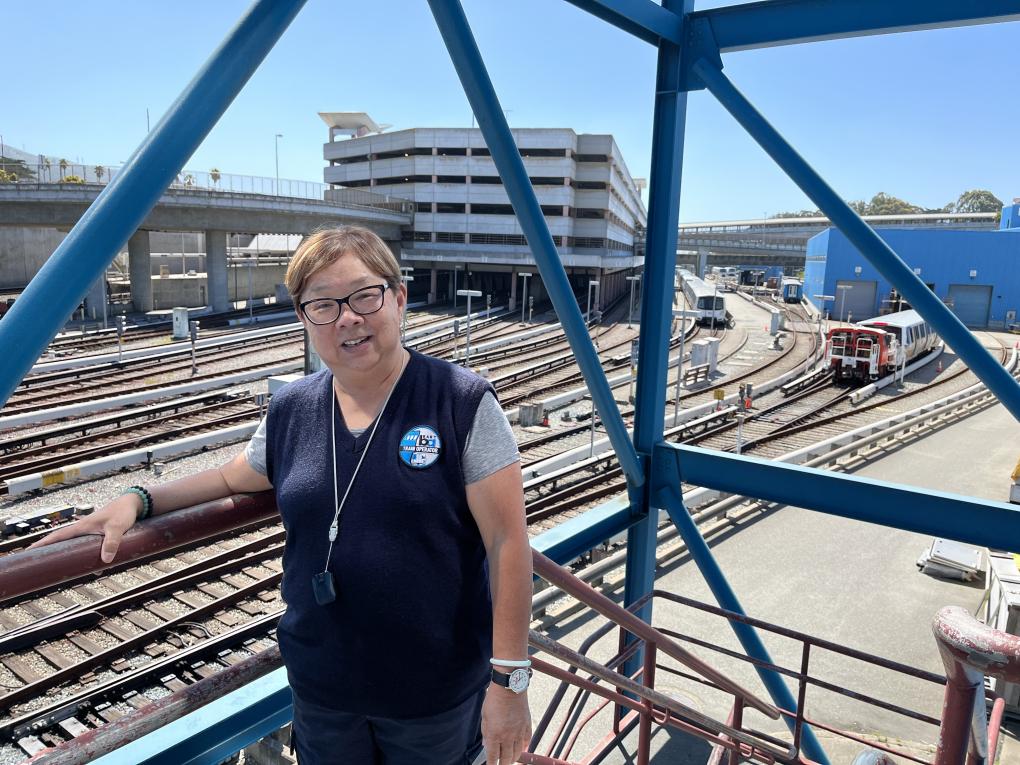
A recent photo of Linda Yee-Sugaya, a.k.a. Mama Linda, at Daly City Yard.
For 33 years, Train Operator Linda Yee-Sugaya, better known as “Mama Linda,” has said a prayer before stepping onto her train.
“Please let me have a smooth day, a good day,” she whispers before hoisting herself into the cab.
She remembers one of her first rides after receiving her Train Operator certification in 1991. She pulled into Embarcadero Station to find it packed with people on all sides and realized: “When I’m operating a ten-car train, I'm responsible for 2,000 people!” And her job was to keep every single one of them safe.
That early anxiety has long evaporated. But Mama Linda still says a prayer before each ride, just in case.
After so many years in the cab of a train car, the seasoned Train Operator has seen a lot. She’s watched the old trains become the new; stations being built and BART lines lengthen; and thousands upon thousands of faces stream past the windows of her train on their way to parades and protests and celebrations. (Fact: Mama Linda's operated trains during every single Giants Championship Parade this millennium.)
But there is one image, seen through the glare of her cab window many years ago, that she holds most dearly: Her father, Dock Ong Yee, waving at her train on the platform at Glen Park.
“My father thought it was the greatest thing that I worked at BART. He would brag to all his friends, ‘My daughter drives the BART trains!’” she said.
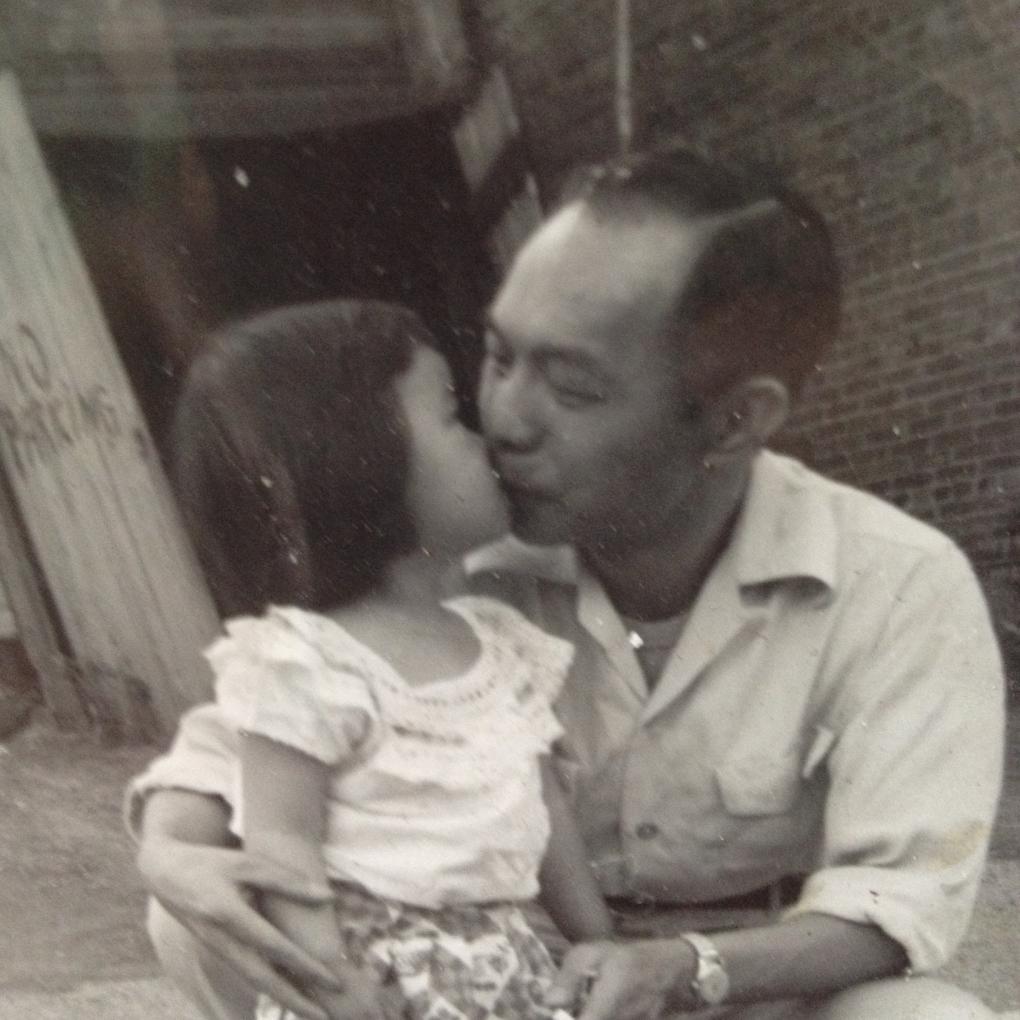
Mama Linda with her father, Dock Ong Yee.
On his way back from Chinatown each day, Dock would take BART from Powell St. and disembark at Glen Park Station, near his house. He’d wait on the platform to see if his daughter’s train went by.
When he didn’t see his daughter pass through the station, Dock would walk up to the cab window and ask the operator: “My daughter, Linda, is an operator. Is her train behind you?”
The trouble was, he always said “Linda,” and without fail, the operator would respond, “Who is that?” Most people at BART knew her then and now strictly as Mama Linda. We’ll get to that story later.
Dock would then go to Mama Linda and say, “How come you’re never on the train? I ask for you, and the operators never say you’re there.”
She’d reply: “Daddy, I am on the train. You have to ask for Mama Linda.”
Only once did their schedules align at Glen Park, he on the platform and she in her cab. Dock got in the first car just behind his daughter’s cab and rode with her to the end of the line. Mama Linda then drove him back home in her car.
Mama Linda grew up in Akron, Ohio. It was the 60s, and the Yees were one of six Asian families in town. Racism and discrimination were routine parts of their life.
Dock immigrated to the U.S. in the early 1940s as a “paper son,” a term referring to people born in China who immigrated to the U.S. and Canada with documentation stating they were related to those who had already received citizenship or residency. On the papers, he was listed as his sister’s son. She lived in Akron, so he did too. A few years after immigrating, Dock joined the U.S. Army and served in China on the “Burma Road.” That’s where he met the mother of his children, Sue Gin Yee, who died in 1957 when the kids were very young.
Dock owned a laundry, and when Akron was undergoing urban renewal in the 60s, the city bought the building. With some moving money in his pocket, Dock packed up the house, and he and his three kids left for San Francisco in pursuit of a better livelihood and more opportunity.
In San Francisco, Mama Linda, 11 at the time, finally began to understand her Asian roots. Back in Akron, she and her family stood out in the crowd, she said. In San Francisco, things were different.
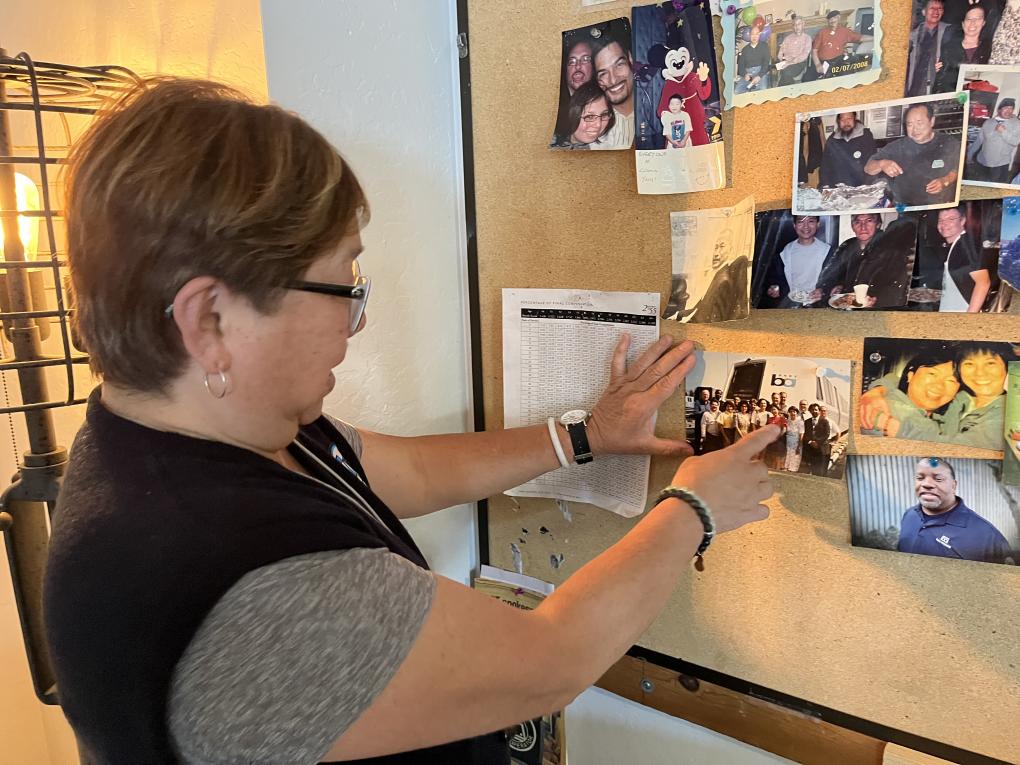
Mama Linda points to a photo of her Train Operator graduating, July 1991, on the massive corkboard at Daly City Yard.
“The first day we were in San Francisco – it was August ‘66 – we walked to Chinatown and saw all these Asian people,” Mama Linda said. “We were amazed. Look at everyone!”
A few weeks later came the first day of school. Mama Linda walked into the classroom and was shocked to find she looked “just like everyone else.” It was a strange feeling, and it took some getting used to.
“I was accustomed to being the center of attention in Akron,” she said. “In San Francisco, I was the same as all the others in my class.”
While growing up, Mama Linda and her younger brother were alone a lot. Their father was working as a custodian at a government building, and her older siblings did their own thing or had moved out. But when the family was home together, the love and joy overflowed.
Dock loved having his kids’ friends over, and he always insisted on feeding them.
“Even my friends called my dad ‘Pops,’” Mama Linda said. “I took after him.”
The “Mama Linda” moniker came into being around 25 years ago, when she was working with a Train Operator in his thirties named Raymond Jew Tsang.
“I’m always telling people what I think they should be doing,” she said. And Raymond was not spared. She always asked him: “Why aren’t you married? Why don’t you settle down?”
“I’d nag him all the time,” she said. “And one day he came over and said, ‘Who are you trying to be? My mama?”
From then on, she couldn’t shake the “Mama” loose from “Linda.”
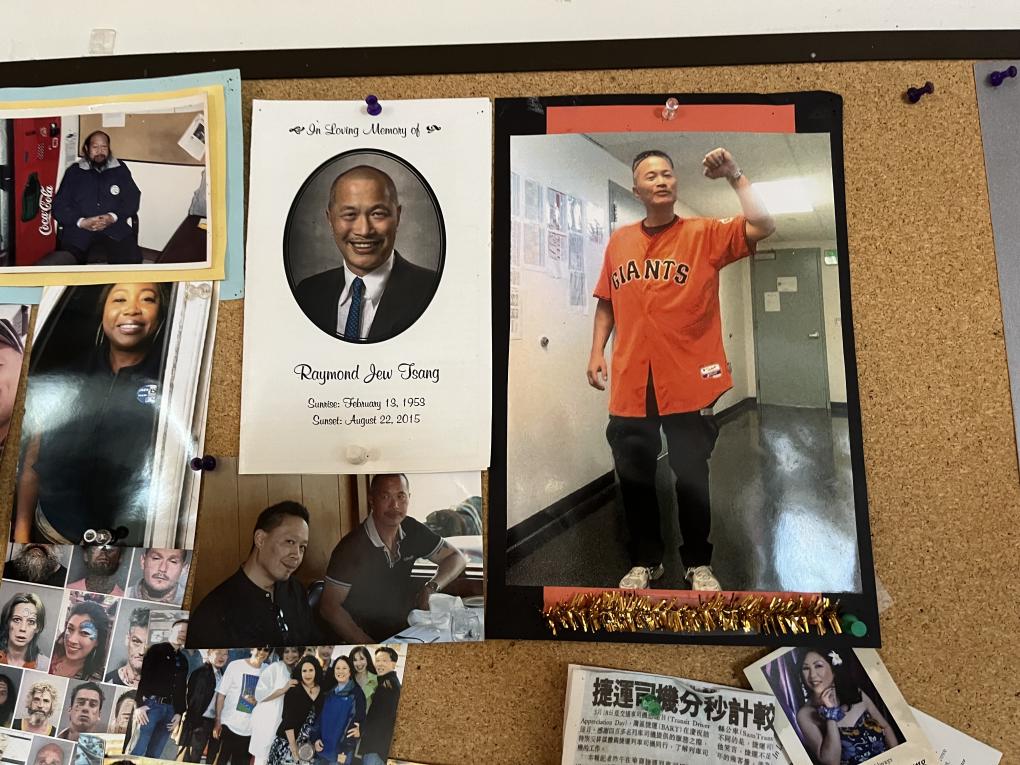
Raymond Jew Tsang is memorialized on the corkboard at Daly City Yard.
Raymond passed away in 2015, and photos of him are still posted to the giant corkboard that’s overtaken a wall in the Daly City Yard breakroom that is so comfy, it feels more like a living room or den. Raymond, Mama Linda said, never did settle down.
Years after earning her nickname, Mama Linda is still mama-ing. She brings food to the Daly City breakroom – and often entire meals for her colleagues to cook together – pretty much every day. Just like her dad, she wants to make sure her friends are well fed.

“Train Operators are in and out throughout the day, and they don’t always have lunch. This breakroom is our second home, we spend so much time here. So I try to keep stuff on the center island in the kitchen,” she said.
On days when the team cooks together, they gather in the kitchen and get crafty with the hot plate, toaster oven, and Instant Pot (donated by Mama Linda herself). Typical meals include pulled pork, Japanese curry, and “hot dog, hamburger, and root beer float day.” On Cinco de Mayo, the on-duty operators made tacos.
At home, Mama Linda said her husband, Alan, does all the cooking.
Mama Linda plans to retire next year, and as these things usually go, she’s feeling bittersweet about it.
“As my career here concludes, I’m just grateful for the last 33 years,” she said. “It’s been a great experience. I think what I’ve gotten out of it the most is the people I met here. I have lifelong friends thanks to BART.” And lots of treasured recipes shared and tested in the breakroom.

She will certainly not lay idle in retirement, however. She likes to craft, travel, and shop. But she’s most excited to sleep in. Those 3:30am wake up calls get old after 33 years. She’s also thrilled to have time to attend her soul-inspired line dancing class. It’s like line dancing, but to soul music – RnB and Motown and oldies.
“My husband doesn’t like to dance,” said. “In line dancing, you don’t need a partner.”
As Mama Linda winds down the BART chapter of her life, she’s already making arrangements to ensure the culture she's stewarded for so long is thoughtfully maintained.
“I’m leaving all my kitchen stuff here, my Instant Pot and everything,” she said. “And I keep asking, OK, who’s going to do the next party?”
This AAPI Heritage Month, she also plans to participate in the events taking place in Japantown, near where she lives. She likes to stay active in the neighborhood.
“I’m proud of my heritage, to be in this position now, to be living this life, knowing what my ancestors have gone through,” she said.
Mama Linda thanks her stars that her dad moved the family west when he did. She went back to Akron in 2007 for the first time since she’d left as a child. Her mother is buried there, so she and her siblings made a pilgrimage to visit her as well as their living relatives in Cleveland.
“It was a coming home thing, but I was also like, geez, I’m glad I don’t live here,” she said. “I love the diversity in the Bay Area. I couldn’t live anywhere else.”

BART wishes you a wonderful Asian American and Pacific Islander (AAPI) Heritage Month. More than 24% of BART employees are members of the AAPI community (as of May 1, 2024), and we want to honor and recognize the ways their heritages and cultures have contributed to BART and our region.
In celebration of the month, BART Communications interviewed Ni Lee, Group Manager and Deputy Project Director for VTA’s BART Silicon Valley Phase II Project. Lee discusses growing up between Taiwan and Southern California, the many lessons she learned working in food service, and shares her favorite recipe for hot pot dipping sauce.
BART celebrates heritage and diversity months throughout the year, and with stories such as Lee’s, we want to recognize some of the exceptional employees in our organization.
Read about two other amazing AAPI BART employees:
- From McDonald’s and Dennys to trains and trackways: How working in food service formed top engineering manager Ni Lee’s work philosophy
- Crisis Intervention Specialist Caryl Blount on BART, family, and food
And check out BARTable’s suggestions for celebrating AAPI Heritage Month near BART stations.
BART Train Operator Dewayne Deams on the lessons he learned from his great-grandfather, transit trailblazer Curtis E. Green
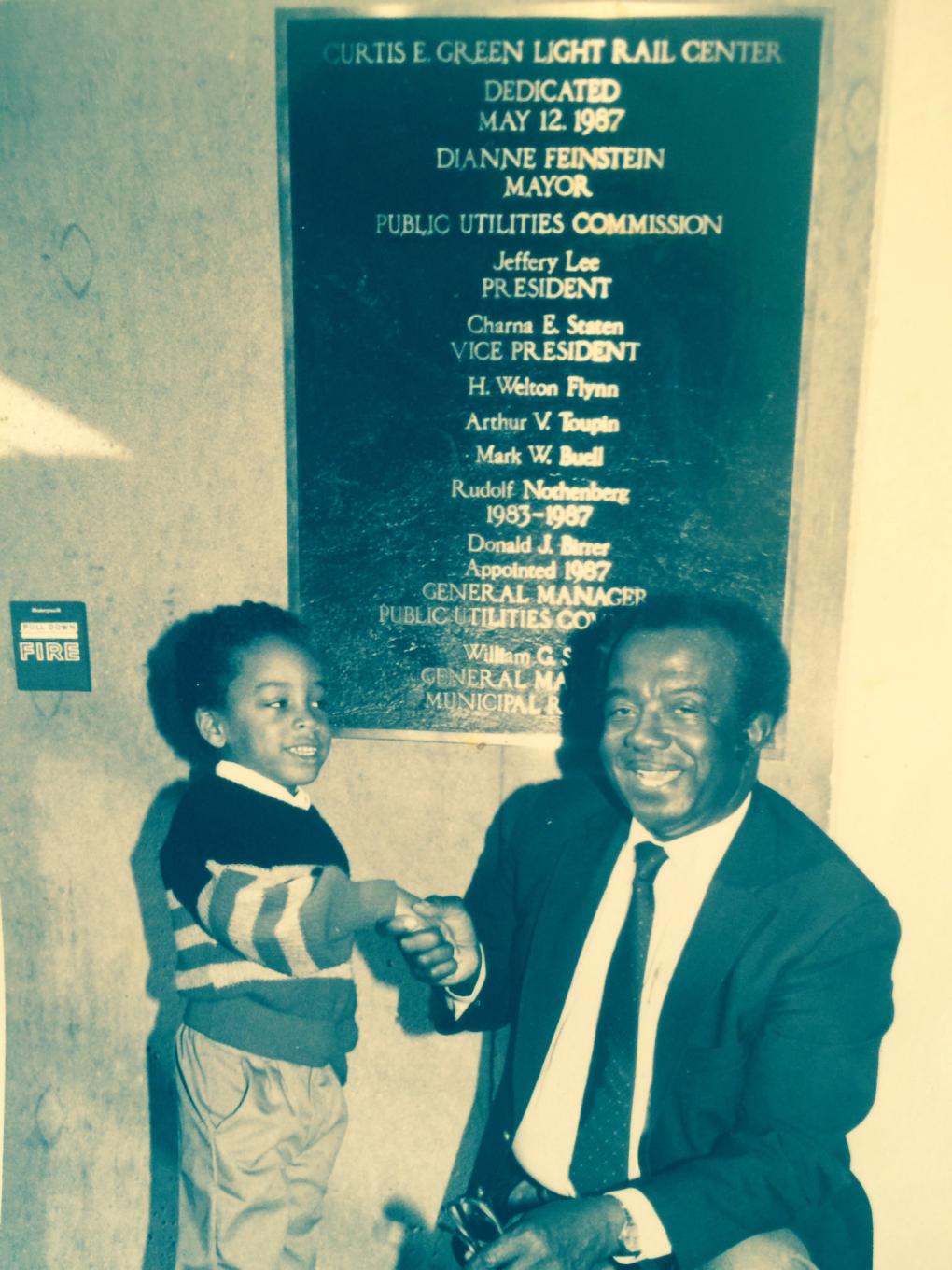
Dewayne Deams (left) with his great-grandfather Curtis E. Green at the dedication ceremony for the Curtis E. Green Light Rail Center on May 12, 1987. Photo courtesy of SFMTA Photo | SFMTA.com/Photo
BART Train Operator Dewayne Deams has digital version of an old photo stashed on his phone. The grainy, sepia-toned image shows a boy, smiling and shaking hands with a gentleman in a suit and tie. There's a plaque behind them that reads: “Curtis E. Green Light Rail Center, Dedicated May 12, 1987."
The boy is Deams as a five-year-old. The gentleman is Curtis E. Green, Deams’ great-grandfather and the first Black person to lead a big-city transit agency in the U.S. Green’s impact on public transportation is immeasurable. For Deams, its personal.
“I don’t have a vocabulary big enough to describe how much his legacy means to me,” Deams said of his great-grandfather. “He’s a trailblazer. In my time with him, I never saw him that way. I didn’t realize he's literally in the history books until I was older.”
Deams started asking questions about the man he knew simply as “granddaddy” after his funeral, at which Willie Brown spoke and a letter by Dianne Feinstein was read. Green died in 2002 at 78 after a long illness. Deams, then 21, had seen Brown and Feinstein on tv. He knew they were famous, but why were they speaking at great-grandpa’s memorial service?
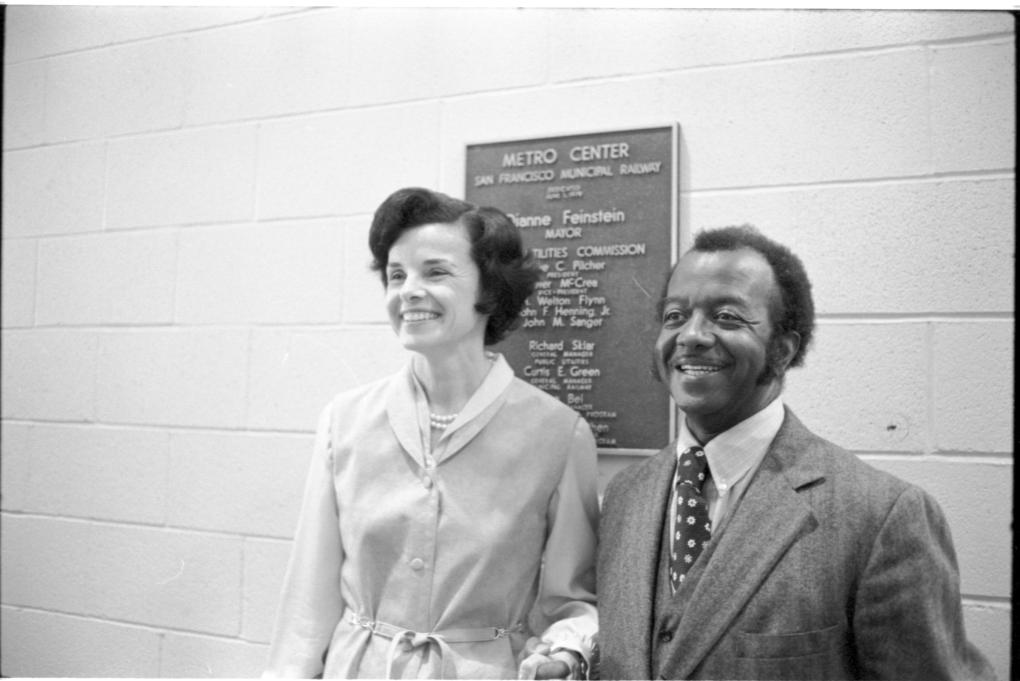
Dianne Feinstein, then the Mayor of San Francisco, and Curtis E. Green at the dedication of the Muni Metro Light Rail System on July 11, 1979. Photo courtesy of SFMTA Photo | SFMTA.com/Photo
Deams said his great-grandfather wasn’t the name-dropping type, and he certainly didn’t know him as “the Muni guy.” Rather, he remembers Green as gregarious and easygoing with a hearty laugh. The two talked about football a lot.
After Green died, Deams started researching, and he quickly came to realize his great-granddaddy was a “big deal.” At the African American Museum and Library at Oakland, Deams found a section all about Green and his legacy.
“I had him for a good while,” Deams said. “But when you’re a kid, you don’t always understand the magnitude of things. It’s like, okay, grandpa, whatever you say. I’m grateful I eventually came to learn the importance of what he accomplished.”
Before he fully understood his great-grandfather’s legacy, Deams said he would sometimes brag to friends and classmates when passing the Curtis E. Green Light Rail Center in Balboa Park.
“I’d say, ‘Look at that name! That’s my grandfather,’” Deams remembers. “That was always a claim to fame for me.”
Transit obviously runs in Deams’ blood, and not only on behalf his great-grandfather. Both of Deams' parents drove buses and light rail for Muni. His mother, Denise Green, is now a supervisor at the agency, where she’s worked for more than 30 years. Twice she’s won the distinguished Driver of the Month award, including when she worked in Green’s namesake division. He attended every one of her awards ceremonies.
“The second time she won, while she was working in the Green Division, he came and spoke about how proud he was,” Deams said. “I get choked up thinking about it. That was one of the last times I saw him before he died.”
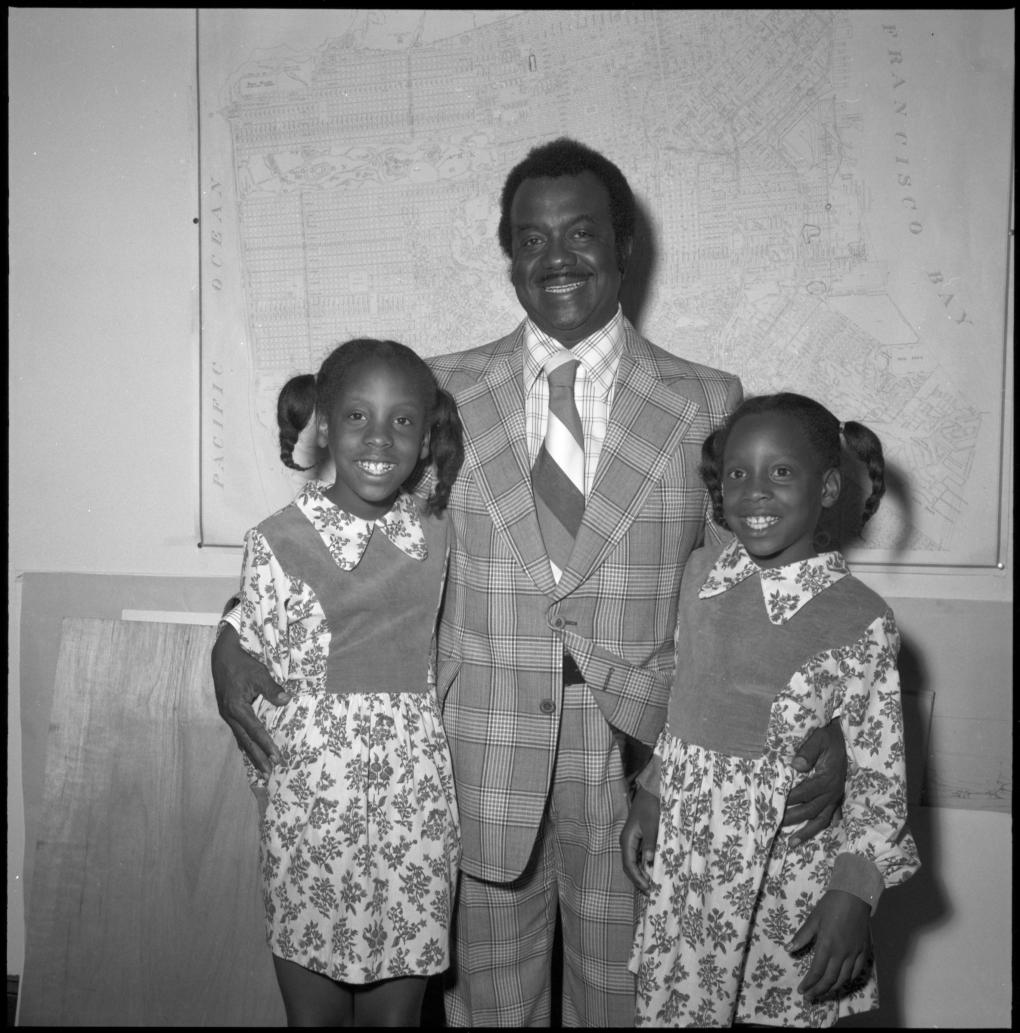
Curtis E. Green pictured with his family on July 23, 1974. Photo courtesy of SFMTA Photo | SFMTA.com/Photo
Green settled in San Francisco after serving in the Marines during WWII. Before the war, it could be challenging to find a job if you were Black -- hiring practices were often blatantly discriminatory. The war opened things up a bit, and in 1945, when Green was seeking a job in San Francisco, many employers suddenly had a shortage of workers on their hands. That year, Green was hired as a bus driver, making 90 cents an hour.
Over his 37-year career at Muni, Green slowly rose in the ranks. He knew he wanted to pursue management, and so he did, earning his degree after years of night classes. In 1974, he became deputy general manager of Muni. A year later, he was promoted to the top spot.
Things were not always easy for Green, his great-grandson said. Back in the day, drivers carried change – riders didn’t have to give exact fare – which sometimes made them targets. Green was once robbed and beat up for his change purse.
He faced challenges because of his race, too, especially as he moved up in the ranks. “’You’re affirmative action. You’re only getting this because they needed to hire a Black guy,’” Deams said, parroting colleagues’ racist remarks. Those words stung his great-grandfather, Deams said, but he always rose above it, touting the importance of hard work above all else.
Green loved his job, the city, working with people, Deams said. When he reached the top of Muni's ranks, he treated everyone the same, whether a janitor or mayor of San Francisco.
Deams carries on his great-grandfather’s legacy in his own way, waking up each morning, hopping in his cab, and striving to give BART riders the best service possible. He describes himself as “a major transit nerd” -- one of the lucky few whose passion is also his job.
Deams said his conduct at work is influenced by his great-grandfather and the example he set. Green believed in killing ‘em with kindness and told his great-grandson that there was nothing wrong with being nice. Deams took that to heart, applying it in scenarios as basic as “seeing someone running to the train doors when I’m operating.”
“I could just take off, but I’m a sucker and hold the doors most of the time,” he said. “People appreciate it. You don’t have to be cutthroat. You can be kind and still get the job done.”
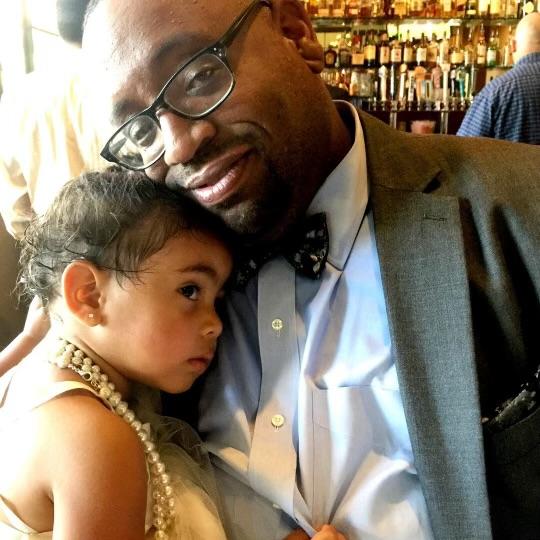
A recent photo of Dewayne Deams with his daughter.
One of his favorite parts of the job, like his great-grandfather, is interacting with people. Deams currently works on the Yellow Line, and he loves “walking the platform to my train, answering questions as I go, and seeing people ride from all over the world.” Typical topics of conversation include baseball and how to get to Fisherman’s Wharf. Once, Deams met a woman boarding the train with her father, who had helped build BART back in the 1960s. Deams was honored to take them for a ride.
Having grown up as a “latchkey kid” in the Bayview District of San Francisco, Deams said public transit was a lifeline for him and his little brother. They took it to school, to baseball practice, to appointments. His favorite spot to take the train growing up was Blondie’s Pizza at Powell Street Station. He and his friends would grab a slice and try to scarf it down before the pigeons beat them to it.
As a teenager one evening, while spending the night at his grandmother’s house, Deams remembered convincing her to give him a $20 bill. He grabbed the cash, took the bus to Colma Station, and rode BART to the Coliseum to watch a Warriors game.
“For $20 at the time – it was the 90s – I was able to get there and back, buy a ticket to the game, and get some nachos,” he said. “My mom was pretty furious when I got back though.”
Now, Deams takes his three daughters around the Bay Area on BART, including to sports games. They’re proud of their dad and his career. BART trains aren’t just BART trains to them, Deams said, but Daddy’s BART trains. Just like his great-grandfather did for him so many years before, Deams is now sharing the joys of transit with his children, teaching them how to use it and why it matters.
“They’re in love with trains,” he said. “Especially BART trains.” Nothing could make him prouder.
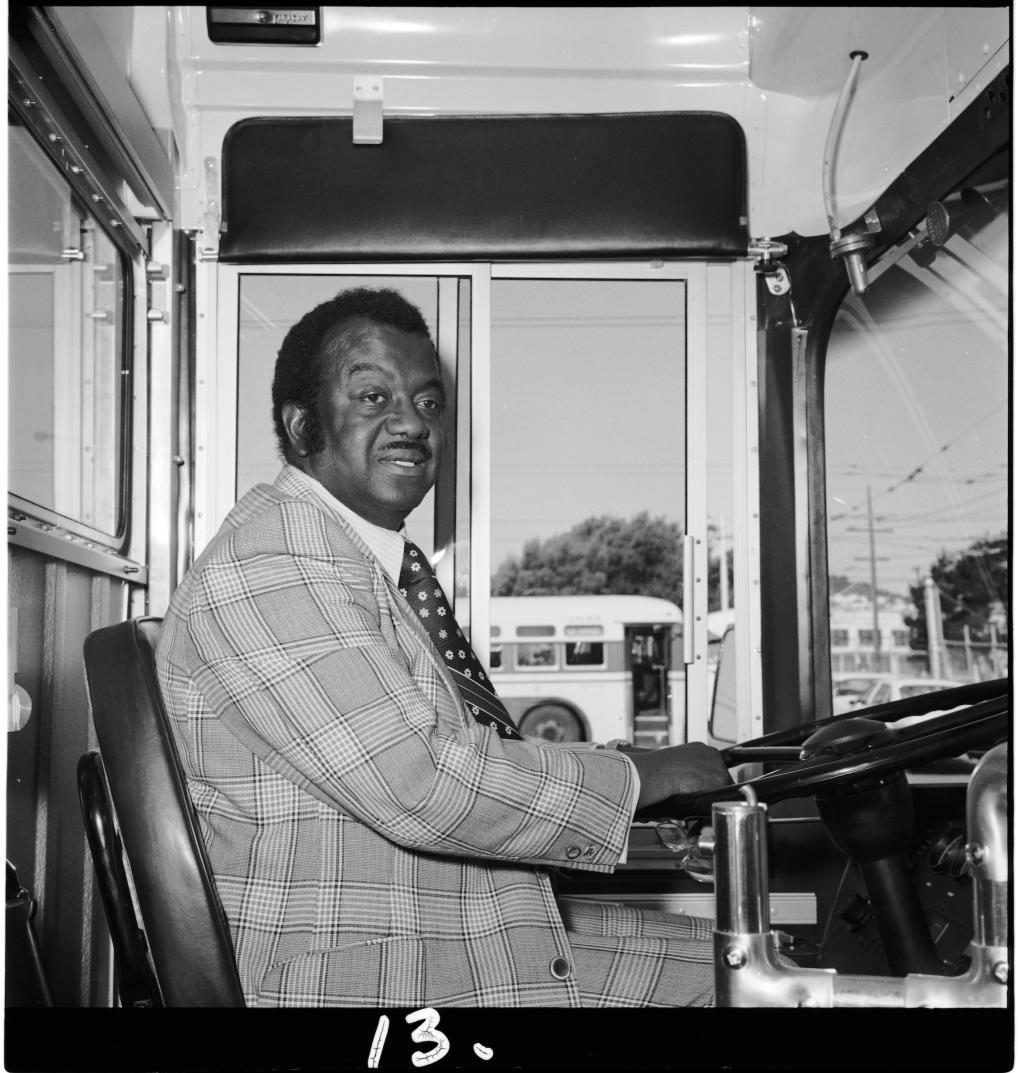
Curtis E. Green at the wheel of a new AM General diesel coach on May 5, 1975. Photo courtesy of SFMTA Photo | SFMTA.com/Photo
“Our systems are more aligned now than ever”: Local transit CEOs take BART, buses, and even an electric trolley during Earth Day ride-along event
Ride-along attendees and transit riders fill a County Connection Route 14 bus. On Friday, April 21, ten transit CEOs from across the Bay Area gathered for a multimodal, three-hour-long voyage that carried them from the green hills of Orinda to the dry heat of Pittsburg. The “All Aboard with Transit CEOs”
